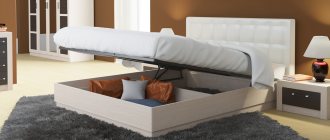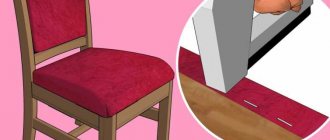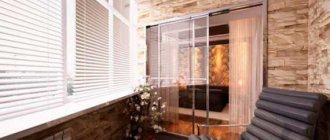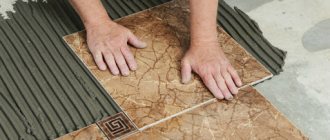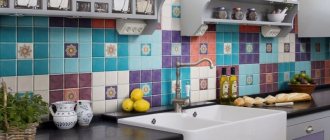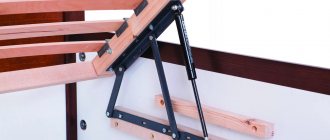Structure of vinyl tiles Main types of tiled linoleum Advantages and disadvantages of tiled linoleum Laying tiled linoleum Preparatory process and installation
Linoleum tiles are known to many, but some have worked with modern building materials, while others have installed a version from the last century in their homes. In the article we will consider the version called vinyl tiles, since it is this version that is popular today for its aesthetics, quality, reliability and durability.
Vinyl tile structure
As mentioned earlier, tile facing material has long been created on the basis of polymers and was used to cover floors. That modification was not of the best quality, and the flooring deformed very quickly given intensive use.
The reason for such negative products is that tile linoleum was previously made in the form of single-layer squares or rectangles. The basis for the material was standard polyvinyl chloride (PVC). Essentially, linoleum tiles were plastic sheets that could not withstand heavy loads.
Modern material is more durable due to its updated structure:
- The product is based on a polyvinyl chloride sheet (vinyl), the thickness of which is no more than 0.5 millimeters. This layer is used to increase adhesion to the base and elasticity;
- followed by softer PVC with a reinforced layer of fiberglass;
- Next is a 2-3 mm flexible vinyl base interspersed with fine quartz sand. It is necessary to stabilize the product and ensure its basic performance properties;
- Decorative paper with a certain pattern or texture is glued on top of the base, making the tile visually beautiful, both in the photo and upon close inspection;
- linoleum in the form of tiles, coated with a layer of polyurethane with various additives, has the highest quality and cost. This coating protects the material from wear, abrasion, fading in the sun, etc. In some cases, polyurethane has a special additive that eliminates the sliding effect.
This combination of linoleum and tiles in one product has significant advantages over other coatings:
- multi-layering allows the coating to withstand the standard load created by residents;
- the materials used in production ensure resistance to the chemical effects of various chemicals;
- The multilayer structure is also excellent in operation due to high depreciation rates, not much different from those inherent in rolled linoleum.
Pros of combining two floor coverings
Before joining linoleum and tiles, you should find out all the pros and cons of this type of combination.
The chosen design allows you to use the features of each material in the right places. Often the load on the floor differs in different areas of the apartment. When people ask how to join linoleum and tiles, designers advise first of all to decide on the zoning of the room and find out what the load will be on each area. In the kitchen, there is a high probability of floor contact with water and cleaning products. It is better to use tiles in this room. It is not afraid of water and resistant to mechanical damage.
Linoleum is a material that gives off heat. Therefore, if you lay this covering in the dining area, your feet will not be cold. Tiles without additional heating are considered a cold coating. Linoleum is convenient to lay and easy to care for during use.
The main advantage of a combined floor is that it is convenient to use tiles in the food preparation area and linoleum in the dining area. The result is a floor covering that is comfortable for feet and original in design. Plus, this combination is not very expensive, unlike laminate and parquet.
Even a beginner in the repair business can work with these materials. You can choose colors that match each other yourself.
The main types of tile linoleum
Previously, the construction market could only offer customers commercial linoleum for tiles, but today you can refuse imitations and buy individual tiles directly.
The following types of such products are known:
- By molding, tiles are distinguished into standard geometric shapes: square, rectangle, triangle, and the hexagon is especially valued by designers, since it can be used to create the most original coatings;
- according to the characteristics of the surface of the tiles: glossy and matte effect, non-standard texture for linoleum and anti-slip effect (abrasive treatment).
Important! It is not recommended to use abrasive coatings in residential areas, as they lead to damage to socks, slippers, etc. It is best to use them in public places, where more durable shoes will not be at risk.
Unlike simply applying a pattern to rolled linoleum, tiles are produced using several technologies, which also determine its classification into several types:
- quartz-vinyl
- 80% consists of quartz ground into sand. High strength and density of products is determined by pressing under high temperature. Quartz itself makes the material resistant to abrasion; - pressed
- created from vinyl, resins, plasticizers and hardeners. The mechanical resistance of this variety is lower than that described above, but higher than that of ordinary linoleum; - self-adhesive panel
– have high elasticity, allowing it to be used as a finishing material for floors, walls, furniture, etc. Structurally, this material is not much different from rolled linoleum.
Choosing a design for such tiles will not be difficult, since almost any wishes of the buyer can be satisfied. Among the tiled materials, not only tiled linoleum stands out, but also more elite types: palace tiles or tiles with a texture that imitates natural wood. There is no limit to the imagination of designers who have even created tiles that imitate crocodile skin.
Linoleum
Unlike ceramic tiles, the physical parameters of linoleum differ significantly depending on the type.
Linoleum is different
Table. Main types of linoleum.
| Type of linoleum | Brief description of parameters |
| Natural | All flooring components are made from natural materials. Strong jute fiber is used as a base; to increase resistance to putrefactive processes, it is impregnated with linseed or other natural oil. The top covering is made from oak bark, wood flour, and limestone. Pine resin holds the components together into a single mass. This coating is the most expensive of all types of linoleum and is used only in exclusive homes. Experienced builders advise that instead of very expensive natural linoleum, make floors from other natural coverings: wood, stone, etc. This is not only much cheaper, but also more practical and durable. Covering expensive natural linoleum with relatively cheap ceramic tiles is complete absurdity. |
| Polyvinyl chloride | Non-woven polymer materials or polypropylene foam are used as the base. It can have a large number of manufacturing options, differing in performance characteristics and appearance. But everyone’s physical parameters are the same. |
| Nitrocellulose | It has a small thickness and is laid on a perfectly flat surface. It is characterized by very high elasticity, which allows the material to be laid on bases that change their linear dimensions within a wide range. |
| Glypthal | The main difference is the woven base. But such materials have a common drawback - different parameters for stretching along and across the fibers. |
| Rubber | Polymer bases. Top layer made of modified rubber. It is used in rooms with high humidity and is not afraid of direct contact with water. |
A common property of all linoleums is low strength. Plastic bends even under the weight of furniture, not to mention serious loads. This property of flooring has an extremely negative effect on the possibility of laying ceramic tiles on top of it.
Types of linoleum
What are the sizes of linoleum
Adhesive for linoleum
The industry produces types of adhesives that have high adhesion to concrete and ceramics. But this does not mean that linoleum adhesive can be used when laying tiles. Glue is rarely used for residential premises; this technology is noticeably more expensive than conventional technology without adhesives. In addition, there is no point in gluing linoleum; it does not have any effect on the service life and quality of the floor surface. But, if it is necessary to replace worn-out linoleum with a new one, big problems arise. Professionals recommend choosing glue depending on the base and planned loads.
The picture shows linoleum gluing using dispersion glue
There are several types of tile adhesive available. Let's briefly look at everything; the knowledge gained will make it possible to understand why laying tiles on linoleum using adhesives is unrealistic.
- Dispersive. The base is an aqueous dispersion of acrylic and carboxymethylcellulose. To improve quality, innovative additives and additives are introduced into the composition. Used for linoleums on fabric, felt or polyurethane base. There are many commercial names of glue brands, but in terms of basic parameters there are almost no differences between them.
Universal adhesive fixer for linoleum and carpet Axton
- Reactionary two-component . Very expensive and very strong glue, it is very difficult to tear linoleum from it, you need to use powerful construction hair dryers. Use in residential areas is not recommended due to the release of aggressive chemical compounds.
Adhesive for linoleum joints
None of the listed adhesives are suitable for laying tiles on linoleum for two reasons. Firstly, they are all very liquid and cannot support the weight of the tiles. The possibility of leveling the floor covering on a horizontal plane is excluded, and this is a very important condition for a quality floor. Secondly, if you increase the thickness of the glue to at least 5 mm, then the cost of flooring increases significantly. The price of two-component adhesives for linoleum is very high.
Two-component epoxy-polyurethane adhesive for linoleum
Dispersion adhesive for natural linoleum
Advantages and disadvantages of tiled linoleum
Naturally, such a coating has both positive and negative sides.
Positive characteristics include:
- modern linoleum with a tile pattern or any other texture has high strength, many times greater than that of rolled linoleum;
- the multi-layer structure makes the material flexible and elastic, facilitating installation and increasing comfort during use;
- the polyurethane layer protects the tiles from moisture and sunlight;
- small proportions of one tile simplify the installation process, since it is easier to join tiles than to lay a long roll perfectly evenly;
- Finally, fire resistance makes the material even safer. And even during combustion, a minimal amount of harmful toxic substances is released.
Vinyl linoleum for ceramic tiles and other types of coatings also has disadvantages:
- the material is susceptible to the formation of dents due to prolonged exposure to heavy objects on its surface;
- the cheapest products have a low-quality polyurethane layer that poorly protects the decorative layer from fading;
- the cost of the material is similar to laminate, so you shouldn’t try to save your budget when choosing this flooring.
Which material to choose: PVC tiles or linoleum, which is better to use for the floor?
Back
Many people, when renovating the floor in an apartment, ask the question, what material to choose? Parquet board, quartz-vinyl facing tiles or linoleum - which is better. and can these coverings be placed on the floor in all rooms?
If the choice is between PVC tiles and linoleum, then both materials win in some ways and lose in others to the other. Therefore, to accurately answer this question, it is worth making comparisons between these products. In this article we will talk about the advantages of laying linoleum and vinyl, comparing the pros and cons.
Linoleum and its characteristics
Like PVC tiles, linoleum is made from artificial materials. It is single- or multi-layer, wear-resistant and can last for decades without loss of quality. To prevent linoleum from slipping on the floor, it is supplied with a felt or jute backing. A pattern is applied to the front side of the coating. The material is divided into three types: household, commercial and semi-commercial. There are also special-purpose coatings. The most reliable and durable products are those of the commercial type, although their prices are much higher. than for semi-commercial and household material.
Domestic type covering Commercial linoleum for office premises Semi-commercial type - the basis of the material
The latter type is suitable for living rooms; it can have different colors and beautiful patterns. Its main advantage is its low price. True, the strength characteristics and wear resistance of household linoleum are significantly lower than those of the other two types. Among the many advantages of linoleum, we primarily highlight the following qualities:
- Soundproofing properties. The material dampens noise, this quality is very important if you live in a multi-story building, the neighbors below will not hear your steps or the sound of objects falling on the floor.
- Thermal insulation qualities. The bottom layer of linoleum improves thermal insulation. And since the coating can be laid directly on the floor, which was laid earlier, these properties increase significantly.
- Moisture resistance. The material does not absorb moisture, so it can be installed in rooms with high humidity. The material is not afraid of direct contact with water; even if a puddle of liquid remains on its surface for a long time, nothing will happen to the coating. Thanks to this property, linoleum can be laid even in open outdoor gazebos.
- Decorative qualities. There are coatings on the market that imitate parquet boards, laminated panels, tiles, stone and other materials.
- Easy installation. In order to lay such a covering on the floor, you do not need to have any special skills; just unwind the roll, lay it down and fix it at the edges.
Attention! If you are laying linoleum on the floor, make sure that the patterns between the two strips match and do not forget to overlap the walls a little if they are uneven.
PVC tiles and their characteristics
To understand which is better - linoleum or PVC facing tiles, let's now learn about the characteristics of the second type of material. PVC tiles are a multi-layer coating with a reliable protective layer that protects the surface from damage.
PVC floor tiles
Among the advantages of such products we highlight the following:
- Moisture resistance. The material is not afraid of moisture and can easily withstand even severe floods, while water does not seep into the structure of the rough base. This quality is especially important if you live in a high-rise building; in the event of a pipe break, the water will not reach the neighbors below, because it will remain on the surface. All you have to do is pick up a rag and collect the water.
- Chemical inertness. This is an important property, because PVC tiles laid on the floor are not destroyed by chemical compounds and household chemicals. But many flooring materials that are more expensive cannot boast of such qualities; their chemical inertness is very low or absent.
- Fire safety. The material is classified as non-flammable and when heated does not emit hazardous toxic substances.
- Antistatic. Vinyl tile floors do not accumulate static electricity and therefore do not attract dust.
- Impact resistance. When heavy and sharp objects fall on the floor, cracks and chips do not form on the tiles.
- Environmental friendliness. In the manufacture of the material, raw materials are used that do not pose a danger to human health.
- Good soundproofing properties. PVC tiles can partially muffle noise.
- Excellent wear resistance. Thanks to the protective decorative layer on the surface, the coating has excellent resistance to damage.
- Laying tiles is not particularly difficult, you just need to adhere to the installation technology.
Installation of tiles on the floor Tile flooring
What is better to use – PVC tiles or linoleum
Now we know what the differences are between these two materials. When choosing products, remember that not every type of linoleum has good resistance to chemicals, and low-quality products, when heated, emit substances hazardous to health (formaldehyde), which can cause cancer.
If water gets under such a coating, then the material may become deformed, and if mechanical damage is caused to the linoleum, then this problem can only be corrected by applying a patch.
As for PVC tiles, there are also disadvantages. The coating does not have good thermal insulation and does not cause a very pleasant sensation when touching it. There are no other significant shortcomings.
If we talk about the installation of these two materials, then in both the first and second cases, the installation of the coating is carried out only on a flat base. Linoleum is laid faster than tiles; it is simply spread on the floor and fixed at the edges, whereas each tile must be installed with glue.
The service life of both floor coverings is estimated at tens of years, but tiles still win here, because this material has better resistance to ultraviolet radiation and has high strength characteristics.
If both coatings are damaged, the situation is also different; a patch of exactly the same color will have to be placed on the damaged area of linoleum, but in tiles such an area can be quickly replaced with a new one. Another important circumstance: it is allowed to install a warm floor under PVC tiles, while linoleum releases hazardous substances when heated.
Is it possible to combine materials?
When creating interiors, designers often combine floor coverings, so you can combine these two materials; the main thing here is to choose the right one. The materials must have a matching pattern and color, in which case an interesting effect can be achieved.
Other materials are also combined with these coatings: laminate, parquet boards. For example, you can lay laminated panels on the floor in the living room, linoleum in the kitchen, and tiles in the hallway. The main thing is that there is no strong difference in color and pattern.
Today the market offers a large selection of floor coverings; their overview is presented in the video:
Average score of ratings is more than 0
laminatepol.ru
Laying tile linoleum
If, for example, you bought white linoleum for tiles or any other, then you can install it yourself. The worker will need the following tools: measuring devices and a marker for marking, a square made of wood or metal, a spatula and grater for the adhesive mixture, a sharp cutter for cutting the material and a rubber roller.
It is advisable to use a cutting tool in which the blade is replaceable, since abrasive coatings will lead to its rapid frenzy. You will also need an adhesive mixture to lay the material.
Preparatory process and installation
As with any floor covering, you will first need to create a perfectly flat base without defects in the form of cracks, chips, depressions and bulges. In case of significant distortions, it is worth pouring a screed (cement-sand or using a ready-made self-leveling mixture) or laying a plywood sheet with a thickness of 0.8 centimeters as a base.
The material should be adapted before installation by bringing it into the room where the work will be carried out in advance. This will reduce deformation during installation and further operation of the coating. Next, marking is done using prepared tools. The most important thing is to make the areas of the floor that will be visible to those entering the room and stand out in the photo if the installation quality is poor. The option of pre-laying tiles without gluing is considered reliable, since you can check how correctly the markings have been made and see what the floor will look like upon completion of the work.
As for installation, the easiest way is to use self-adhesive semi-commercial linoleum under the tiles, because It is enough to simply lay it on the base by first peeling off the protective film from the bottom. But this option, as mentioned above, is not reliable and high-quality, so we will next consider the process of laying more durable varieties of vinyl tiles.
Variety of artistic solutions
Linoleum floor tiles, like a laminate, can imitate natural wood.
Linoleum floor tiles, shown in the photo, can, like a laminate, imitate natural wood so realistically that even from a close distance you can see indentations and veins, a unique texture. And only after a very careful examination, and having additionally tried the material by touch, can you guess that this is a vinyl coating. Vinyl tiles that imitate stone or ceramic flooring look good.
Various sizes of tiles allow you to use a variety of color combinations when laying floors and vary the direction of laying. Straight lines of deck flooring, a square pattern of parquet boards, or the familiar herringbone pattern - this is an incomplete list of possible installation options.
Self-adhesive floor tiles: composition and artistic solutions
Regular tiles are laid out in the following sequence:
- an adhesive mixture is prepared (acrylic dispersion);
- a layer of substance of 1.5-3 millimeters is applied to the tile with an approximate consumption of 0.3-0.4 kilograms per square meter. Before using the mixture, it should be left to steep for 5-10 minutes;
- gluing vinyl tiles should begin from the corner of the room opposite the front door with a distance of 0.5-1 centimeter from the wall in case the tiles expand under the influence of high temperatures;
- additional leveling is done using a rubber roller or cork board. When processing the coating, it is important not to move the tiles from their intended locations;
- seams between adjacent products must be sealed with cold welding if there is high air humidity in the room.
In those places where the tiles meet other coverings, decorative metal thresholds are installed. This element will protect the joining floorings from deformation and prevent the seam from clogging. Also, under the coverings, various insects and bacteria will not find a new place to live.
Bottom line
The idea of replacing standard roll material with vinyl tiles is a very good one. The advantages of such coating are undeniable and therefore the high cost is quite natural. Since its installation is quite simple, you won’t have to spend money on help from builders. If all the work in the house is carried out exclusively by hired workers, then they can be entrusted with responsibility for all stages - from the choice of coating, naturally, taking into account the wishes of the owner, to the finishing processing of the created cladding.
Technologies for laying modular (tiled) linoleum.
Storage and transportation 1. Storage of floor coverings • When storing in a warehouse, maintain the appropriate internal room temperature from 1C to 30C. • Do not expose to direct sunlight or moisture. Store tiles away from snow and rain. 2.Transportation The material is heavy, care should be taken when transporting the tiles.
Installation Floors must be clean, smooth, dry, level and structurally sound. • Remove existing floor covering. New flooring must not be laid over old flooring. • Dry the base (humidity less than 5%). Never lay floor tiles on a wet surface. • Clean the base. Remove traces of stains, dust, paint, fats and oils, bitumen, varnish, wax, glue and other contaminants. The substrate should not contain materials that could prevent good adhesion. Do not use cleaning mixtures, solvents, lemon adhesive removers, or acid etching to clean the substrate. • All cracks, recesses, holes must be leveled. Use self-leveling compounds. 2. Precautions It is strongly recommended to keep the flooring in a horizontal position and the adhesive at a temperature of 20C to 30C for at least 48 hours before and after installation. ATTENTION: Before installation, it is necessary to check the quality, color and pattern of the coating. Try to use material from the same batch. The batch name contains information about the color and batch number, as well as the production date.
Application area of coatings
Linoleum is recommended as flooring in hospitals and clinics
Despite its widespread use in residential premises, linoleum has always been considered a floor covering for commercial use. This is due to the features of its operation:
- due to the protective layer it is waterproof;
- does not enter into chemical reactions with aggressive acids;
- easy to disinfect;
- abrasion resistant.
Quartz vinyl is an environmentally friendly material, and it can be safely installed in children's rooms
Quartz vinyl is an interior material. Of course, given its high performance qualities, it can even be used in car washes. But will this be worthwhile? Hardly.
Nevertheless, quartz-vinyl, along with linoleum, tiles and porcelain tiles, is included in a limited number of floor coverings intended for laying on floors in medical institutions and industrial premises.
Why is commercial linoleum widely used in residential apartments?
How to lay tiled linoleum - features of the material
Similar lot numbers indicate similar product types. 3.Where to start laying floor tiles • Find the center of one wall of the main rectangle, and from this point draw a line to the opposite wall. Then find the center of the other wall of the rectangle and draw a line to the opposite wall. The center of the main rectangle for the cover will be the point of intersection of these lines. • For a test installation, lay a row of tiles from the center to the side wall. This will help you determine the distance from the end tile to the wall. If the distance between the edge of the last tile and the wall is more than 1/2 tile, mark new center lines 1/2 full tile away from the previous center. • When tiling a room with a different shape, check the size of the last tile on each wall and then change the center lines slightly to help you achieve the best results. 4. Applying Adhesive • Start with 1/4 of the area of the room. Apply the adhesive evenly using a flat V-notch spatula, leaving no seals of adhesive. The optimal glue consumption is 0.3-0.4 kg per sq.m. • Check the crystallization time of the glue. This period of time is calculated from the moment a layer of adhesive is applied to the coating until it completely dries, i.e. when other objects are not glued to the coating. Determining the crystallization time of the glue allows you to make subsequent gluing stronger. It depends on the climate, porosity of the base, etc. More detailed information can be obtained from the technical specifications of the adhesive manufacturers. If the crystallization time is too long, the maximum bonding strength will be lost. • Each floor covering must be installed using a special adhesive and trowel. ATTENTION: In case of unfavorable moisture and temperature conditions of the room, use two-component polyurethane glue. 5. Laying tiles Tiles should be laid from the center of the room to its corners. Place the tiles according to the positions of the arrows on the back side. Lay the tiles without displacement. Before pressing it firmly to the floor, adjust it to the edges of the already laid tiles.
6. Laying tile pieces • To lay tile pieces, lay the tile to be trimmed exactly on top of the last full tile; Place another full-length tile against the wall and mark a cut line where the tiles overlap. • Cut the tiles along the line. Before laying, check that the cut tiles fit well. Do not force it into place. • Lay the tiles and press them into place. ATTENTION: For laying against a wall, it is necessary to roughly cut off the excess tiles in accordance with the contour of the wall, leaving a 1mm margin. 7. Completion of work • Roll a roller weighing 10-30 kg lengthwise and crosswise over each section of tiles for 30 minutes after laying the section of tiles. If in some places it is impossible to roll with this roller, use a hand roller. Perform a visual inspection during the rolling process to ensure that the tiles have not moved and that there is no adhesive on the surface of the tiles. Check each laid section after rolling to check for any raised edges. Roll the roller lengthwise and crosswise a second time for about 30 minutes. If necessary, roll again. • Sweep the floor. • Remove debris and construction materials. • The floor can be washed 48 hours after installation. Stains can be removed with a damp cloth. • It is recommended to install furniture and other items on new flooring no earlier than 48 hours after installation. When installing furniture, it is recommended to use cardboard and dollies. • When working with heavy objects, use cushions to avoid damaging the coating. Necessary tools and materials • For installation: metal scraper, chalk for marking, measuring tape, rubber (wooden) hammer, square, art knife, rag or sponge, spatula with grooves for applying glue, heavy tamping shaft, glue, flooring coating. • For care: mop (for cleaning the floor, with a sponge or cloth), sweeping brush, wax mastic, detergent.
At the moment, the industry offers a very large number of materials for flooring: parquet, laminate, tiles and many others.
But the most economical is linoleum. It is quite easy to care for, durable, and inexpensive. For a very long time, these qualities were the main ones when choosing this material. Today, linoleum tiles are becoming more and more popular.
Linoleum for tiles is, first of all, a very convenient material. It has proven itself to be easy to use for any design option. The ability of such a pattern to visually expand the room is highly valued. Very often the question arises before renovation: to lay linoleum under the tiles or just tiles.
Method with metal edges
In this scheme, it is not necessary to use metal pads, as they are needed to simplify cleaning. It prevents water and dust from getting under the tiles.
The method involves the use of two metal edges. The execution process is as follows:
- Trim the linoleum so that the overlap on the surface of the tile is 4-10mm.
- Glue the linoleum so that its edge fits as tightly as possible to the end of the tile.
- Place a piping on the seam and a weight weighing up to 7 kg on it.
- After the glue hardens, using scissors or a saw, the crown is trimmed, and the seam that remains after this is filled with hot glue.
Visually, it does not look as good as with a threshold, therefore, most people lay a decorative strip on top, which, as practice has shown, very quickly falls off and is thrown away.
Basically, when making joints, a situation arises when cracks appear or poor adhesion of the material to the base or peeling of the plank. It all depends on the installation of the trim.
Why is linoleum so popular?
Linoleum has long lived up to all expectations placed on it. That is why it is the most common material for covering kitchen floors.
This is due to its durability and not being picky. And factors such as spilled water or anything else (which is very common in kitchen areas) do not affect the coating in any way, unlike, for example, laminate, which can swell due to moisture.
The advantages of this material are ease of selection for a specific design (the assortment is very large), ease of care (just wash, you can use various chemicals, except caustic ones), non-slip thanks to a special coating, good resistance to mechanical stress, and, of course, such the floor is much warmer than tiles.
If we consider flooring options for the kitchen, then you should pay attention to wear resistance, ease of maintenance, and reliability.
What do we do before purchasing?
If you still decide to buy linoleum, then first of all you need to think about the purpose, find out everything about the manufacturer (country and company), how long it can last and the presence of all the required certificates (hygienic, quality compliance), storage conditions and subsequent packaging can also be quite a lot important.
Before purchasing, you should also pay attention to the division of linoleum into household, commercial and semi-commercial.
Domestic
Household linoleum is intended for use at home. That is, in rooms with low traffic and load.
Usually it is quite thin (1.2 - 1.6 mm), but it is believed that this is quite enough for using such material at home. Of course, such linoleum is inexpensive, but its service life is very short - about 5 - 7 years.
Article on the topic - features of reinforced household linoleum. We recommend reading.
Important: the floor on which such linoleum is laid must be level.
Semi-commercial
Semi-commercial linoleum is a floor covering with high wear resistance for rooms with medium load. It has properties very similar to commercial ones.
The protective coating layer has a thickness of 0.5 mm; the coating is made of wear-resistant material.
PVC is the basis of commercial linoleum, this is the main difference between commercial and semi-commercial linoleum. Often, this flooring material can be reinforced with fiberglass mesh, which provides thermal and sound insulation.
Purchasing this material will not be difficult for you, since it is available in any store that deals with flooring. Its cost may vary, it all depends on the composition and, of course, on the manufacturer. But still, buying linoleum for tiles will cost you less than laying the tiles themselves. You will be pleased with the relatively low cost of the material.
What floor to make in the kitchen: choosing a floor for the kitchen area
Choosing flooring for the kitchen today poses a difficult task for the apartment owner. The materials are very diverse, and many coatings have undeniable advantages. In order not to make a mistake and not to lay a kitchen floor covering that will create problems during operation, you need to clearly understand the basic requirements for materials.
What floor to make in the kitchen
- Injury safety. The floor in the kitchen must not slip and should not have a clearly defined relief, in other words, it should not provoke falls.
- Wear resistance. The kitchen is the busiest room in the house. In addition, here finishing materials are exposed to steam and various liquids, sometimes containing acids and alkalis.
- Hygiene. Every housewife will appreciate easy daily care of the kitchen floor.
- Environmental friendliness. The flooring should not release harmful substances into the kitchen air.
In addition to such purely functional factors, when choosing, it is worth taking into account the compliance of the floor material with the kitchen design concept, as well as its aesthetic advantages. It is important to assess the required budget; both the price of the material and the cost of installation work are important.
The most popular materials for kitchen floors
The most popular materials for kitchen floors
Linoleum
Linoleum is produced on the basis of natural and polymer resins. The advantages of natural coating follow from its natural origin. The resins used in it not only do not emit harmful formaldehydes, but also have a bactericidal effect. True, such linoleum is more fragile than synthetic one. Impregnation with linseed oil leaves a long-lasting odor, although the aroma itself can have a beneficial effect on people with poor health.
Linoleum for the kitchen
Laying natural linoleum depends on the form of its release. It can be rolled, tile, or even equipped with a multi-layer backing with a locking joint, like a laminate. The cost of natural linoleum is several times higher than PVC. The surface pattern is not very diverse - it can be monochromatic, marbled, or wood-like.
Tiled linoleum
Advantages of natural linoleum or marmoleum for the kitchen:
- is resistant to any impact;
- its strength increases over time;
- does not miss;
- easy to clean.
Marmoleum
Synthetic linoleum, depending on the thickness of the final protective coating and the presence or absence of a substrate, may or may not be suitable for installation in the kitchen. The best option is to choose semi-commercial linoleum with a protective layer thickness of 0.3 mm. It is worth considering that the presence of a bulky and loose substrate can lead to the linoleum sagging under the legs of the table and floor cabinets. Synthetic linoleum is produced in rolls. This greatly simplifies the installation process.
Properly selected linoleum for the kitchen has the following advantages:
- relatively low cost;
- variety of designs and color variations;
- hygiene;
- softness and sufficient noise absorption;
- does not require very careful preparation of the surface for installation.
The disadvantages of such a floor include insufficient resistance to acids, the ability to deform over time, and low resistance to mechanical damage. Linoleum in the kitchen only lasts for a limited time.
PVC tiles
PVC tile floor in the kitchen
A much more durable finishing material that is perfect for laying kitchen floors. It consists of individual tiles made of multilayer plastic with a wear-resistant top layer that is heat and moisture resistant. This almost silent coating, available in a wide range of different decors, is rapidly gaining popularity.
Manufacturers claim the long service life of PVC tiles, and their modular nature allows you to replace the damaged part of the floor if necessary. In all respects, this is an excellent option for arranging a kitchen floor. Self-adhesive tiles are very easy to install. The only drawback is its high price.
Ceramic tiles or porcelain tiles
Ceramic tiles or porcelain tiles
Another environmentally friendly type of flooring that has been used for finishing kitchens since ancient times. Ceramics are based on natural clays, sand, and some minerals. Through special processing, a finishing material that is very durable and absolutely resistant to aggressive influences is obtained. For laying the floor in the kitchen, a variety of tiles measuring 30x30 cm or a combination of large and smaller tiles is most often used.
Finding suitable floor tiles for a kitchen in Provence or high-tech style will not be difficult, as the range of collections on offer is so large.
Provence ceramic tile collection
Some varieties have a textured surface. This floor looks very advantageous, and the following advantages of ceramic tiles speak in its favor:
- complete absence of harmful secretions;
- exceptional strength;
- inertness to acids, detergents;
- resistance to abrasion and mechanical damage.
A successful combination of ceramic flooring and kitchen furniture in the interior
But you need to be very careful when choosing and purchasing floor tiles. It may be difficult to determine the required number of tiles, and if you have to buy more, a new batch from the same collection will most likely be slightly different in tone from the one purchased previously. Therefore, it is worth making a layout in advance and providing a small margin for defects. Ceramic flooring requires skilled installation, and the cost of the craftsman’s work will have to be added to the fairly high cost of the material itself. The base on which the floor will be laid must be perfectly level, otherwise the tiles may crack. And these features of using ceramic tile floors are worth keeping in mind:
- such a floor is always cold, and in a family with children it is better to equip it with a heating system;
- ceramic floor transmits sound well;
- smooth tiles can be dangerous in terms of injuries;
- All glass objects falling on such a floor easily break.
Despite some difficulties, it should be recognized that a ceramic tile floor in the kitchen meets all the requirements of functionality and aesthetics.
Laminate
A finishing material widely used for laying floors in apartments, but not recommended for use in the kitchen. Even a moisture-resistant type of laminate has an area near the locking joint that is not protected from external influences. Spilling water on such a floor can easily ruin it. It is this circumstance that prevents us from recommending laminate flooring for the kitchen.
Laminate in the kitchen
In all other respects - in terms of strength, beauty, ease of installation and price, this floor is quite good. Therefore, there are often cases when laminate flooring in the kitchen is combined with ceramic or PVC tiles laid in the most humid places. This technique is especially justified where the kitchen is not a separate room, but an area in the common living room or dining room. In this way, you can achieve high functionality of the floor and save money.
Less common kitchen flooring options
Self-leveling floors 3D
This technology has become widespread recently. The base is a colorful substrate, usually made using photo printing, and filled with a polymer composition.
Self-leveling floors 3D
This floor looks like a single whole. The floor surface is smooth, glossy, but not slippery, injury-proof. The absence of cracks and chemical resistance of this floor make it quite suitable for the kitchen. But in the absence of special care, the surface becomes dull over time; polymer self-leveling flooring is not very resistant to abrasion. Of course, the main reason why you can decide to install such a floor in the kitchen is to create an individual interior.
Self-leveling floors 3D
Both materials and work to create a self-leveling floor are expensive. The filling process occurs in stages and is quite lengthy. At first, the new floor needs very careful and careful handling. But it is precisely this floor that makes it possible to make the kitchen truly unique.
Cork covering
More and more often there are apartments where the kitchen floor is lined with cork. Despite the apparent fragility of such a coating, cork is perfect in this situation.
Cork covering
Here are its advantages:
- very comfortable soft surface that is pleasant to walk on;
- the adhesive plug (without a locking connection) is absolutely moisture resistant;
- excellent heat insulator;
- Excellent sound dampening;
- antistatic, does not accumulate dust and is easy to clean;
- quickly restores its shape.
This set of properties makes cork flooring in the kitchen the best choice for families with small children. The only thing that cork floors are afraid of is scratches. It is better to equip furniture that will have to be moved with soft pads. Otherwise, this floor will not disappoint even the most demanding owner. Cork flooring is available in a wide range of textures. Imitating the structure of wood, leather, stone - modern cork floors can decorate any room.
Cork flooring
Floor installation requires professional surface preparation. The only significant drawback of this flooring is the high price of the material and the work involved in laying the cork flooring.
Parquet and parquet boards
Natural wood floors react strongly to changes in humidity. That is why their use in the kitchen is not advisable. Like laminate, it is better to combine such floors with more moisture-resistant floors.
Video - Kitchen renovation. Glass floor
pol-spec.ru
Linoleum tiles: selection and installation technology of vinyl covering
Commercial
Installation process
And now a little about what commercial linoleum is. It appeared on the market relatively recently. Designed for use in commercial premises, that is, in premises where a lot of people pass through during the day.
Regarding the price: it will cost a little more, but is more durable and not sensitive to chemicals.
Linoleum may differ in its composition. It is divided into natural and artificial, homogeneous and heterogeneous.
Natural consists of linseed oil, wood and cork flour, resins and natural pigments, and the base is natural fibers. Thanks to this, it can serve you for 30 to 40 years.
The production technology of this floor covering has remained almost unchanged over time; manufacturers have just learned to depict various beautiful patterns on the covering, including tile patterns.
Kitchen floors always require additional coating. Using linoleum is a very convenient and justified option. Its cost is relatively low, and its quality is not inferior to other floor coverings.
Another advantage of linoleum is that many types have an antibacterial effect, and retain it throughout its service life. And some have antifungal treatment, but this property of the coating weakens significantly over time.
About market leaders
One of the most famous manufacturers today is the Belgian company Beauflor. It specializes in the production of high-quality, natural linoleum.
It is natural linoleum that is distinguished by its wear resistance. Therefore, if you choose linoleum for tiles, you should pay attention to this manufacturer.
Linoleum has an additional top layer, which makes it low maintenance, less likely to need polishing, more durable and economical. And the increased density of the base improves resistance to severe damage.
Of course, there are different types of linoleum, and when you decide that you will lay this particular floor covering, you will be faced with the question: “Which tile should be imitated?”
Let's look at a few types:
- The most traditional pattern is for ceramic tiles. This pattern came into fashion back in the last century and still remains relevant. Of course, it is not entirely suitable for modern designs, but it is still in demand.
- Imitation of block parquet and wide parquet boards. Very often not only beech, oak, cherry are reproduced, but also more exotic species such as bamboo, rosewood and others.
- Decor imitating mosaics on wood (marquetry technique) is in great demand today.
- For lovers of extraordinary things, manufacturers can offer a wide variety of colors, geometric or abstract designs.
- Stone-like linoleum looks very nice.
- As an option, you can consider narrow rectangular planks.
Tarkett linoleums are developed using the latest and most modern technologies, taking into account the latest trends in the world of design.
This manufacturer produces only environmentally friendly material that meets all standards and hygienic standards. That is why it is very often used in hospitals, kindergartens, and schools. Linoleum from Tarkett has a high degree of sound and heat insulation, which frees you from unnecessary financial waste and increases the level of comfort.
We hope that this article will help you choose the right linoleum. Happy renovation!
Appearance of coatings
A pattern of homogeneous linoleum is applied over the entire thickness of the coating. Due to this, even with constant load on the linoleum, the design is not erased. However, due to its single-layer nature, homogeneous linoleum is limited in terms of design diversity. As a rule, it will be a monochromatic coating, either with imitation marble or speckled.
The pattern of heterogeneous linoleum is applied to a separate layer using engraved printing cylinders, using 4–5 different colors. There is a transparent protective layer above the design, and when it wears over time, the design will also be erased.
Heterogeneous linoleum has more decor options. There is linoleum with imitation of various natural materials, and with abstract design, and with patterns.
And yet, in appearance, linoleum is inferior to quartz-vinyl. The decorative layer of quartz-vinyl tiles is made using high-resolution printing and accurately imitates the texture of various types of wood, stone, leather and even grass. In addition, the design is reliably protected by the main (PVC) and additional (polyurethane) protective layers. And scratches that appear during use of the floor will only be on the top layer, and the pattern will remain intact.
Advantages and disadvantages
Snow-white flooring has the following advantages:
- Visual increase in area;
- Light colors of the coating give the interior nobility;
- Acts as an additional light source, reflecting sunlight and artificial light;
- Plain milky material gives the room spaciousness, lightness and airiness;
- The white board color material will be an excellent backdrop for bright and unusual accessories.
There are no ideal floor coverings; they have not only advantages, but also disadvantages. They need to be studied during interior planning.
The material also has the following disadvantages:
- If there is an excess of light tone in a room, it looks cold and empty;
- On the sunny side the material may turn yellow;
- Any traces, debris, dust are clearly visible.
Keep in mind that when laying white linoleum on the floor, all debris will be visible, as well as traces of tea, coffee or felt-tip pens.
However, light-colored flooring material has more positive aspects than negative ones. The main thing is to choose the right pattern and texture.
Design for white linoleum
White linoleum in the interior goes well with furniture and appliances in the interior. The light color of the floor will harmonize perfectly with the black doors that are popular today. A floor of this color visually increases the area of the room, which is very important for those who have a small apartment.
To the kitchen
A white floor in the kitchen will create a feeling of cleanliness and comfort, and if the room is small, it will also visually increase the area of the room. You can choose white linoleum for the kitchen under the laminate; it will be practical, cheap, and practically indistinguishable in appearance.
Of course, all the dirt will be visible on such a floor, and you will have to clean it quite often. In addition, a pure white kitchen can create the appearance of a hospital.
Designers recommend choosing not a purely light floor for the kitchen, but one with the addition of other shades, patterns or colors. For example, linoleum with black and white tiles will look good.
To the hallway
The hallway is a high-traffic area, so it is recommended to install thicker household flooring material. If the room is narrow and dark, then it can be visually expanded with a light floor. Although it will need to be washed frequently.
A stone-like canvas will look elegant.
Linoleum for the kitchen
Everyone knows that linoleum is usually rolled into rolls, sometimes a couple of meters wide. Of course, it has its advantages - lay it down, secure it and forget it. But if it turns out that the room does not have the shape of a perfect rectangle, the disadvantages begin to emerge. For example, you have to cut pieces from a huge sheet to fit it to the shape of the floor. Often this problem arises in the kitchen of a private house - there is an underground floor, you have to cut a rectangular hole somewhere inside a solid sheet, but you really don’t want to start cutting from the edge, because then the seam will be visible.
And this material is very dense and generally capricious. I want to cut out a corner, but it turns out to be some kind of shapeless hole. To solve such difficulties, you can use linoleum, which is immediately cut into small squares. In addition to the ease of adjusting to the shape of the floor, there are other advantages. It is easier to smooth it out when gluing it, to expel the air from under it. This means it will hold on tighter. If you wish, you can lay out some pattern on the floor from squares of different colors - a simple checkerboard or something more complex. Plus, there is no need to put anything on the seams - it is quite thin and fits well, with very small gaps between the squares. Well, an indisputable plus for the kitchen or, say, the hallway - if one square is damaged, you can tear it off and replace it with another.
I glued these squares with Bustilat glue. Outwardly, it looks more like white water-based paint - color, thickness and even the can. The gluing process is similar to wallpapering:
1) prepare the surface, that is, the floor, clean it, vacuum it or sweep away the garbage, wash it and let it dry;
2) apply glue to the linoleum sheet and the part of the floor where we are going to glue this square. You need to smear thickly and evenly, without fear of staining more of the floor than necessary - bustilate is very easy to wash off even when dry;
3) we lay the square and the most difficult and important thing begins - we expel the air from under it so that it does not fall off. To do this, smooth it out, pressing firmly, from the center to the edges. The edges, by the way, also need to be thoroughly smoothed and pressed down. According to the technology, it is necessary to then press the square with something heavy - this provides additional guarantees of good adhesion. Basically, I only pressed those leaves that were uneven.
As a result, we get a very nice floor, perhaps with our own design, adjusted to the shape of the room with less effort and easy to repair.
Author: Nadezhda Fedorova
Linoleum with a tile pattern
In this case, it is not necessary to buy expensive natural material, but give preference to linoleum.
As an interesting design solution, you can lay linoleum in black and white squares in the hallway.
Living room
The living room is designed in soothing colors that set the mood for relaxation and a comfortable pastime. To give the interior an expensive look, you can lay linoleum in the color of white marble. This coating will look good in an interior where there are plaster statues, a fireplace or massive furniture.
White glossy linoleum will look interesting in the living room. This material will perfectly suit the style, which will make the room beautiful and unusual.
Children's
The children's room should be light, so it is advisable to use light shades for flooring. You can find material options that combine white color with an original pattern, produced specifically for children's rooms.
Bedroom
When choosing the color of linoleum for a bedroom, many designers advise choosing light, pastel or milky tones. In this color the room looks unusual, but for the bedroom it will be very useful.
Regardless of whether the style is classic or modern, light colors will look good in it. It will add tenderness and softness to the classic style. White color in a modern style is a sign of minimalism, as all attention is focused on the surface, making the entire interior less noticeable.
Characteristics of ceramic tiles
To resolve the disagreements that have arisen, you must first understand how linoleum can have a negative impact on the condition of the tile covering or on the method of its installation. Any ceramic product is produced by firing, which can be done once or twice. After the second procedure, the surface of the object becomes less rough. But the strength of the product weakens. Therefore, floor items are fired only once. The number of firings performed on a specific specimen is marked on the packaging container with the corresponding number against the background of feathers of flame. Among other things, if the tile option is floor, the foot is displayed on the black spot. If the field on which it is drawn is shaded, this means that the ceramic plate has high hardness and resists abrasion. This property is of great importance for the operation of the product in areas of heavy traffic, for example, hallways or corridors. As for kitchens and bathrooms, it is advisable to use tiles that are resistant to any cleaning agents.
This product is very sensitive to mechanical shocks, and therefore tiles on an elastic soft base will be less susceptible to damage than if they were lying on a hard surface. The elastic base acts as a shock absorber and softens the blow, while the hard base, on the contrary, makes it stronger. We must not forget about the fragility of this material. This indicator is of great importance when transporting ceramic products. For example, porcelain stoneware is more impact resistant than earthenware. But during transportation it can easily collapse. Flexural strength is characterized by the maximum force load on fracture and the strength limit. The higher the density of the building material and the lower its ability to absorb moisture, the greater the last value. The maximum force load on deflection determines the quality of ceramic tiles. Among other characteristics, the quality indicator also depends on its thickness.
Photo gallery (6 pcs.)
From the photographs you can understand what white linoleum looks like in the interior:
Most often it is made in the style of wood and boards, less often it is a monotonous coating.
We offer a comparison with how embossed wood-look linoleum in light and dark shades will look.
Caring for white linoleum
One of the advantages of white linoleum is that it is easy to clean. To prevent dust from flying around, it is better to vacuum the floor rather than sweep it. Following simple rules for caring for the coating will help not only extend its service life, but also preserve its appearance:
- Do not use hot water for cleaning;
- Bright sunlight will cause the coating to fade;
- Do not dry or ventilate in winter to prevent cracking;
- Do not use abrasive cleaning products when cleaning;
- Do not use detergents containing chlorine;
- When cleaning wet, wring out the cloth well.
It is not recommended to clean the white oak patterned flooring with bleaching agents, otherwise the pattern will be destroyed.
Traces from furniture are clearly visible on a light-colored canvas; this can be avoided by placing wooden plates under the legs. It is advisable to use special care products for coating.
Snow-white Tarquette flooring can be used for various rooms, be it a spacious living room or a small bedroom.
By choosing the right tone and texture, you can get an extraordinary and beautiful floor that you won’t want to hide under a lot of furniture.
Basic rules for laying tiles on linoleum
Before laying, the tiles are determined with a pattern. If the rows are even, it is optimal to glue the first element in a visible place, for example, in the center of the room. The next rows of tiles are laid from there. For convenience, markings can be applied to the subfloor. Laying from the middle provides an important advantage. If a row of solid tiles cannot be laid out, then the cut element will fall under the wall, where it will be covered by furniture and baseboards.
The laying out of even rows begins from the middle of the room
When laying is carried out diagonally, it is optimal to select the starting point from the window line. Be sure to keep the rows parallel. Otherwise, you will get a deviation that will be very noticeable.
When performing work for the first time, it is optimal to practice laying several rows dry without glue. Training will give you a little skill to avoid such a mistake as rows going to the side. When the general principle is clear, the main process begins. The glue is prepared according to the instructions. The quantity is small so that you have time to work it out before it hardens.
The glue is applied with a notched trowel. The tiles are laid and pressed to the floor. The next element is pressed close to the previous one. Then the tile is moved back a little, a plastic cross is inserted into the seam, and leveled.
After applying the adhesive with a notched trowel, press the tiles to the floor with your hands.
Laying tiles is carried out by checking the level of evenness of the rows. A cross is inserted into each seam. If pieces are needed near the wall, the tiles are cut with a tile cutter. A day later, the crosses are removed from the sutures. The gaps are filled with grout. The composition selected in a suitable color is applied with a rubber spatula. The stained tiles are wiped with a damp sponge.
This video will help you lay tiles on linoleum:


